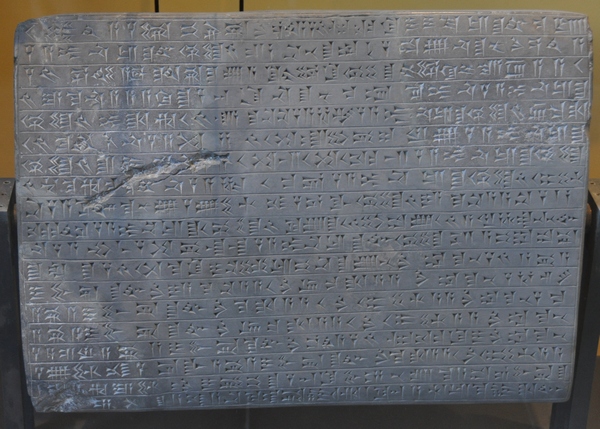Susa and the inscription of Darius I
Located in the lower Zagros Mountains in Iran, the modern town of Shush is located on the site of ancient Susa/Shushan, mentioned in the Books of Esther, Daniel, Nehemiah and Jubilees and "The Persians" a Greek tragedy from 472BC that is the oldest surviving play in the history of theatre.
Image 1: Map
In the Achaemenid period, Darius the Great commissioned a palace to be built in both Susa and Persepolis. The two palaces have a great deal of similarity, so the missing elements from excavations of Susa are hypothesised from its better-preserved sister palace. In Susa, a famous inscription written in Old Persian, Babylonian and Elamite languages has been discovered upon many fragments in marble, clay and glazed tiles.
In this text Darius tells how he built the royal palace of Susa and imported products from all over his empire.
This palace which I built at Susa, from afar its ornamentation was brought. Downward the earth was dug, until I reached rock in the earth. When the excavation had been made, then rubble was packed down, some 40 cubits in depth, another part 20 cubits in depth. On that rubble the palace was constructed. And that the earth was dug downward, and that the rubble was packed down, and that the sun-dried brick was molded, the Babylonian people performed these tasks.
The cedar timber, this was brought from a mountain named Lebanon. The Assyrian people brought it to Babylon; from Babylon the Carians and the Yaunâ [=Greeks] brought it to Susa. The yakâ-timber was brought from Gandara and from Carmania.
The gold was brought from Lydia and from Bactria, which here was wrought. The precious stone lapis lazuli and carnelian which was wrought here, this was brought from Sogdia. The precious stone turquoise, this was brought from Chorasmia, which was wrought here.
The silver and the ebony were brought from Egypt. The ornamentation with which the wall was adorned, that from Yaunâ was brought. The ivory which was wrought here, was brought from Kush and from India and from Arachosia.
The stone columns which were here wrought, a village named Abirâdu, in Elam - from there were brought. The stone-cutters who wrought the stone, those were Yaunâ and Lydians.
The goldsmiths who wrought the gold, those were Medes and Egyptians. The men who wrought the wood, those were Lydians and Egyptians. The men who wrought the baked brick, those were Babylonians. The men who adorned the wall, those were Medes and Egyptians.
Darius the King says: At Susa a very excellent work was ordered, a very excellent work was brought to completion.
Translation:
Pierre Lecoq, Les inscriptions de la Perse achéménide (1997 Paris)
Image 2: Susa, DSf (Babylonian) ca. 520 BCE–486 BCE
As you can see the empire of Darius and his successors included many peoples. In the below image, you can see the statue of Darius and then a list of 24 countries subject to Darius from the base of the 3-meter tall statue of Darius found at the Kings Gate of Susa.
Image 3: Statue of Dar
Below are a few images of the floor plan of the Palace at Susa.
Image 5: Plan of Susa
Image 6: Map of Susa, Achaemenid Palace
(Image 1 : Map :Attribution: File:Near East topographic map-blank.svg: Sémhur File:Elam-map-PL.svg: Wkotwica derivative work: Morningstar1814 Creative Commons Creative Commons Attribution-Share Alike 3.0 Unported)
(Image 2: Attribution Jona Lendering: Licence CC0 1.0 Universal)
(Image 3: Statue: Attribution: Fabien Dany - www.fabiendany.com / www.datka.kg Creative Commons Attribution-Share Alike 2.5 Generic license.
(Image 4: Attribution: Davide Mauro: Creative Commons Attribution-Share Alike 4.0 International license.)
(image 5: Map of Susa: Attribution: Jona Lendering, Licence CC0 1.0 Universal)
(Image 6: Map of Susa, Achaemenid Palace: Attribution: Jona Lendering, Licence CC0 1.0 Universal)







